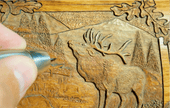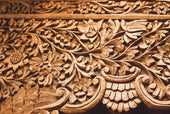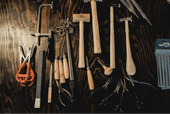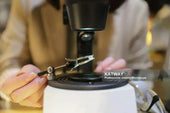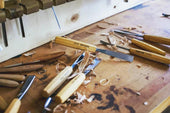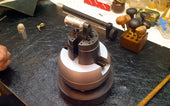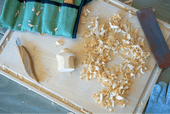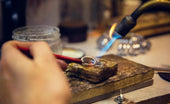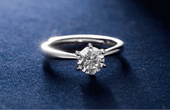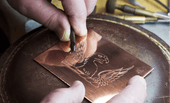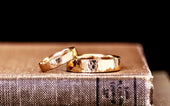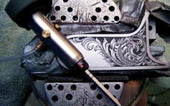The easiest way to color wood carving
Woodcarving painting is the process of painting wooden carvings with colors to make them look more beautiful and artistic. Today, I will introduce a simple method for coloring wood carvings.
Preparation work
Prepare paint and brushes. Choose water-based or oil-based pigments according to your preferences and needs. It should be noted that the color should coordinate with the texture of the wood and not be too dazzling or abrupt.
Brushes need to be chosen with a softer texture and finer bristles.
Polish the surface of the wood carving smooth to remove burrs and rough parts. Surface treatment also includes repairing scars, cracks, and insect holes. Generally, small areas can be filled with latex mixed with wood sawdust or gypsum powder. Large area cracks can be repaired using the "inlay" method, using wooden strips or chips of the same material to cut into a narrow inner and wide outer shape, then dipped in latex and embedded into the crack. After the glue dries, a knife can be used to repair and level the surface together.
Apply primer. Before coloring the wood carving, we need to apply primer. Primer can protect wood and enhance its color. Primers can be selected from water-based or oil-based primers that are the same as pigments.
Color adjustment
The main method of coloring wood carving handicrafts is to make the wood and patterns clear and visible under the cover of pigments, and some wood grains become clearer after coloring. So when mixing colors, do not be too thick. The ratio of pigment to water is 30:1, and it should be appropriately thin and transparent. Even if brushed multiple times, the wood will not be covered. If the colors are properly mixed, coloring three times is enough, but it needs to be done once and again.
The color to be mixed depends on the work. But regardless of which one, as long as there are 3-4 colors in harmony, too many colors will cause a dirty color sensation. Too few colors will appear thin and lack a sense of thickness. Beginners can experiment on wood while mixing pigments until they reach a satisfactory color. You can also find some wood samples or scraps and place them aside as a reference.
The water content of the colored brush should not be too high, and there should be no rush to achieve results, otherwise some deep recesses will accumulate color and produce uneven effects.
The coloring of wood carving handicrafts is not only to compensate for the shortcomings or defects of wood, but also to enrich the material texture and form of the work. Therefore, when coloring the work, it should be decided according to the needs of the content and form of the work as much as possible, and conform to the various beauty of natural wood.
Attention, do not immediately polish the wood carving crafts after coloring. Be sure to wait until it dries, then use a clean cloth to vigorously wipe until a uniform gloss is produced, achieving a smooth hand feel. Some wood carving crafts can be omitted according to the situation, making the base color of the wood slightly exposed, forming a rich color feeling, and also strengthening the layering of the work.
Coloring
Apply the first layer of paint. Dip an appropriate amount of paint onto the paintbrush and apply it evenly to the surface of the wooden carving. Do not apply paint too thick to avoid affecting the texture of the wood. After applying the first layer of paint, wait for it to dry.
Wait for the first layer to dry, then apply the second layer of paint. The concentration of the second layer can be slightly increased to enhance the saturation and depth of the color.
Fix details. After applying the second layer of paint, we need to repair some details. For example, some indentations and corners may be missed and need to be carefully repaired with a small brush. You can also use colored lead to add color to details, such as the nose, cheeks, and chin of a character, painting them red with a halo, or using a highlighter to decorate them.
Finally, apply protective paint. Protective paint will play a role in protecting wood and color.
matters needing attention
When applying paint, do not over color. Excessive coloring can affect the texture of wood, causing the wood carving to lose its original beauty.
Pay attention to color matching. The color should coordinate with the texture of the wood and not be too dazzling or abrupt.
Pay attention to the direction of the painting. The direction of painting should be consistent with the wood grain, maintaining the original texture of the wood.
After coloring the wood carving, it cannot be immediately waxed or polished. Be sure to wait for the paint to dry before using old fine sandpaper. There are not many sand particles on the surface anymore. Use it to gently rub and polish the wood on the surface of the wood carving, leaving behind the colored powder until it feels smooth to the touch.
In short, coloring wood carvings is a job that requires attention to detail and patience. Only with sufficient preparation and precautions can beautiful and exquisite wooden carvings be produced.
View more related articles
Ring Sizing Tips - How to measure?
Katway Istanbul Jewelry show Guide
Comparison between hand engraving and machine engraving










